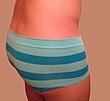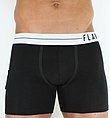Going Commando
Undergarments are generally of two types, those that are worn to cover the torso and those that are worn to cover the waist and legs, although there are also underclothes which cover both. Different styles of underwear are generally worn by females and males. Undergarments commonly worn by females today include bras and panties (knickers in British English), while males often wear boxer briefs or boxer shorts. Items worn by both sexes include T-shirts, sleeveless shirts (also called singlets, tank tops, A-shirts, or vests), classic briefs, bikini briefs, thongs, G-strings and T-fronts.
Terminology
Undergarments are known by a number of terms. Underclothes, underclothing and underwear are formal terms, while undergarments may be more casually called, in Australia, Reg Grundys (rhyming slang for undies) and Reginalds, and, in the United Kingdom, smalls (from the earlier smallclothes) and (historically) unmentionables. In the United States, women's underwear may be known as delicates due to the recommended washing machine cycle or because they are, simply put, delicate.
Women's undergarments collectively are also called lingerie. They also are called intimate clothing and intimates.
An undershirt (vest in the United Kingdom) is a piece of underwear covering the torso, while underpants (often called pants in the United Kingdom), drawers, and undershorts cover the genitals and often buttocks. Terms for specific undergarments are shown in the table below.
Function
Underwear is worn for a variety of reasons. They keep outer garments from being soiled by perspiration, urine, semen, pre-seminal fluid, feces, vaginal discharge, and menstrual blood. Women's brassieres provide support for the breasts, and men's briefs serve the same function for the male genitalia. A corset may be worn as a foundation garment to provide support for the breasts and torso, as well as to alter a woman's body shape. For additional support and protection when playing sports, men often wear more tightly fitting underwear, including jockstraps and jockstraps with cup pocket and protective cup. Male dancers sometimes wear dance belts for support and modesty while wearing tights. Women may wear sports bras which provide greater support, thus increasing comfort and reducing the chance of damage to the ligaments of the chest during high-impact exercises such as jogging.
In cold climates, underwear may constitute an additional layer of clothing helping to keep the wearer warm. Underwear may also be used to preserve the wearer's modesty – for instance, some women wear camisoles and slips (petticoats) under clothes that are sheer. Conversely, some types of underwear can be worn for sexual titillation, such as edible underwear or crotchless panties.
Undergarments are worn for insulation under space suits and dry suits. In the case of dry suits, the insulation value of the undergarments is selected to match the expected water temperature and the level of activity for the planned dive or water activity.
Some items of clothing are designed exclusively as underwear, while others such as T-shirts and certain types of shorts are suitable both as underwear and as outer clothing. The suitability of underwear as outer clothing is, apart from the indoor or outdoor climate, largely dependent on societal norms, fashion, and the requirements of the law. If made of suitable material, some underwear can serve as nightwear or swimsuits.
Religious functions
Undergarments can also have religious significance:
- Judaism. To conform with societal dress codes, the tallit katan is often worn beneath the shirt.
- Mormonism. Following their endowment in a temple, Mormons wear special temple garments which help them to remember the teachings of the temple.
- Sikhism. One of the five articles of faith (panj kakaar) worn by Sikh men and women is a certain style of underpants similar to boxer shorts and known as the kacchera.
- Zoroastrianism. Zoroastrians wear an undershirt called a Sedreh that is fastened with a sacred girdle around the waist known as a Kushti.
History
Ancient history
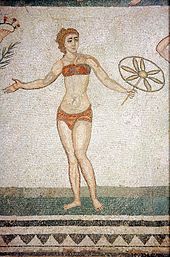
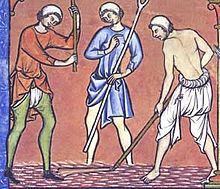
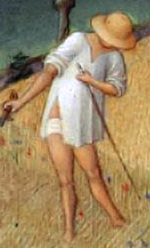
The loincloth is the simplest form of underwear; it was probably the first undergarment worn by human beings. In warmer climates, the loincloth was often the only clothing worn (effectively making it an outer garment rather than an undergarment), as was doubtless its origin, but in colder regions, the loincloth often formed the basis of a person's clothing and was covered by other garments. In most ancient civilizations, this was the only undergarment available.
A loincloth may take three major forms. The first, and simplest, is simply a long strip of material that is passed between the legs and then around the waist. Archaeologists have found the remains of such loincloths made of leather dating back 7,000 years. The ancient Hawaiian malo was of this form, as are several styles of the Japanese fundoshi. Another form is usually called a cache-sexe: a triangle of cloth is provided with strings or loops, which are used to fasten the triangle between the legs and over the genitals. Egyptian king Tutankhamun (1341 BC – 1323 BC) was found buried with numerous linen loincloths of this style. An alternate form is more skirt-like: a cloth is wrapped around the hips several times and then fastened with a girdle.
Men are said to have worn loincloths in ancient Greece and Rome, though it is unclear whether Greek women wore undergarments. There is some speculation that only slaves wore loincloths and that citizens did not wear undergarments beneath their chitons. Mosaics of the Roman period indicate that women (primarily in an athletic context, whilst wearing nothing else) sometimes wore strophiae (breastcloths) or brassieres made of soft leather, along with subligacula which were either in the form of shorts or loincloths. Subligacula were also worn by men.
The fabric used for loincloths may have been wool, linen or a linsey-woolsey blend. Only the upper classes could have afforded imported silk.
The loincloth continues to be worn by people around the world – it is the traditional form of undergarment in many Asian societies, for example. In various, mainly tropical, cultures, the traditional male dress may still consist of only a single garment below the waist or even none at all, with underwear as optional, including the Indian dhoti and lungi, or the Scottish kilt.
Middle Ages and Renaissance
In the Middle Ages, western men's underwear became looser fitting. The loincloth was replaced by loose, trouser-like clothing called braies, which the wearer stepped into and then laced or tied around the waist and legs at about mid-calf. Wealthier men often wore chausses as well, which only covered the legs. Braies (or rather braccae) were a type of trouser worn by Celtic and Germanic tribes in antiquity and by Europeans subsequently into the Middle Ages. In the later Middle Ages they were used exclusively as undergarments.
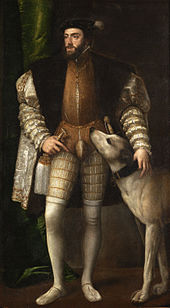
By the time of the Renaissance, braies had become shorter to accommodate longer styles of chausses. Chausses were also giving way to form-fitting hose, which covered the legs and feet. Fifteenth-century hose were often particolored, with each leg in a different-colored fabric or even more than one color on a leg. However, many types of braies, chausses and hose were not intended to be covered up by other clothing, so they were not actually underwear in the strict sense.
Braies were usually fitted with a front flap that was buttoned or tied closed. This codpiece allowed men to urinate without having to remove the braies completely. Codpieces were also worn with hose when very short doublets – vest- (UK: waistcoat-) like garments tied together in the front and worn under other clothing – were in fashion, as early forms of hose were open at the crotch. Henry VIII of England began padding his codpiece, which caused a spiralling trend of larger and larger codpieces that only ended by the end of the 16th century. It has been speculated that the King may have had the sexually transmitted disease syphilis, and his large codpiece may have included a bandage soaked in medication to relieve its symptoms. Henry VIII also wanted a healthy son and may have thought that projecting himself in this way would portray fertility. Codpieces were sometimes used as a pocket for holding small items.

Over the upper part of their bodies, both medieval men and women usually wore a close-fitting shirt-like garment called a chemise in France, or a smock or shift in England. The forerunner of the modern-day shirt, the chemise was tucked into a man's braies, under his outer clothing. Women wore a chemise underneath their gowns or robes, sometimes with petticoats over the chemise. Elaborately quilted petticoats might be displayed by a cut-away dress, in which case they served as a skirt rather than an undergarment. During the 16th century, the farthingale was popular. This was a petticoat stiffened with reed or willow rods so that it stood out from a woman's body like a cone extending from the waist.
Corsets also began to be worn about this time. At first they were called pairs of bodies, which refers to a stiffened decorative bodice worn on top of another bodice stiffened with buckram, reeds, canes, whalebone or other materials. These were not the small-waisted, curved corsets familiar from the Victorian era, but straight-lined stays that flattened the bust.
Men's braies and hose were eventually replaced by simple cotton, silk or linen drawers, which were usually knee-length trousers with a button flap in the front.
Medieval people wearing only tunics, without underpants, can be seen on works like The Ass in the School by Pieter Bruegel the Elder, in the Très Riches Heures du duc de Berry by Limbourg Brothers, or in the Grimani Breviary: The Month of February by Gerard Horenbout.
In 2012, findings in Lengberg Castle, in Austria, showed that lace and linen brassiere-like garments, one of which greatly resembled the modern bra, date back to hundreds of years before it was thought to exist.
Enlightenment and Industrial Age
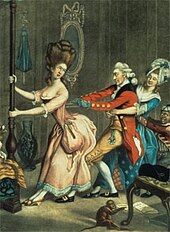
The invention of the spinning jenny machines and the cotton gin in the second half of the 18th century made cotton fabrics widely available. This allowed factories to mass-produce underwear, and for the first time, large numbers of people began buying undergarments in stores rather than making them at home.
Women's stays of the 18th century were laced behind and drew the shoulders back to form a high, round bosom and erect posture. Colored stays were popular. With the relaxed country styles of the end of the century, stays became shorter and were unboned or only lightly boned, and were now called corsets. As tight waists became fashionable in the 1820s, the corset was again boned and laced to form the figure. By the 1860s, a tiny ("wasp") waist came to be seen as a symbol of beauty, and the corsets were stiffened with whalebone or steel to accomplish this. While "tight lacing" of corsets was not a common practice except among a minority of women, which sometimes led to a woman needing to retire to the fainting room, the primary use of a corset was to create a smooth line for the garments to effect the fashionable shape of the day, using the optical illusion created by the corset and garments together to achieve the look of a smaller waist. By the 1880s, the dress reform movement was campaigning against the alleged pain and damage to internal organs and bones caused by tight lacing. Inez Gaches-Sarraute invented the "health corset", with a straight-fronted busk made to help support the wearer's muscles.
The corset was usually worn over a thin shirt-like shift of linen or cotton or muslin. Skirt styles became shorter and long drawers called pantalettes or pantaloons kept the legs covered. Pantalettes originated in France in the early 19th century, and quickly spread to Britain and America. Pantalettes were a form of leggings or long drawers. They could be one-piece or two separate garments, one for each leg, attached at the waist with buttons or laces. The crotch was left open for hygiene reasons.

As skirts became fuller from the 1830s, women wore many petticoats to achieve a fashionable bell shape. By the 1850s, stiffened crinolines and later hoop skirts allowed ever wider skirts to be worn. The bustle, a frame or pad worn over the buttocks to enhance their shape, had been used off and on by women for two centuries, but reached the height of its popularity in the later 1880s, and went out of fashion in the 1890s. Women dressed in crinolines often wore drawers under them for modesty and warmth.

Another common undergarment of the late 19th century for men, women, and children was the union suit. Invented in Utica, New York and patented in 1868, this was a one-piece front-buttoning garment usually made of knitted material with sleeves extending to the wrists and legs down to the ankles. It had a buttoned flap (known colloquially as the "access hatch", "drop seat", or "fireman's flap") in the back to ease visits to the toilet. The union suit was the precursor of long johns, a two-piece garment consisting of a long-sleeved top and long pants possibly named after American boxer John L. Sullivan who wore a similar garment in the ring.
The jockstrap was invented in 1874, by C. F. Bennett of a Chicago sporting goods company, Sharp & Smith, to provide comfort and support for bicycle jockeys riding the cobblestone streets of Boston, Massachusetts. In 1897 Bennett's newly formed Bike Web Company patented and began mass-producing the Bike Jockey Strap.
1900s to 1920s
This section needs additional citations for verification. (January 2012) |
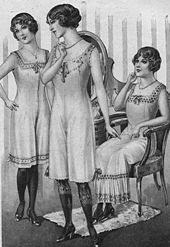

By the early 20th century, the mass-produced undergarment industry was booming, and competition forced producers to come up with all sorts of innovative and gimmicky designs to compete. The Hanes company emerged from this boom and quickly established itself as a top manufacturer of union suits, which were common until the 1930s. Textile technology continued to improve, and the time to make a single union suit dropped from days to minutes.
Meanwhile, designers of women's undergarments relaxed the corset. The invention of new, flexible but supportive materials allowed whalebone and steel bones to be removed. The emancipation or liberty bodice offered an alternative to constricting corsets and, in Australia and the UK, the liberty bodice became a standard item for girls as well as women.
Men's underwear also continued to be developed. Benjamin Joseph Clark, a migrant to Louisiana from New Jersey, opened a venture capitalist firm named Bossier in Bossier Parish. One product manufactured by his firm was tightly fitting boxer shorts that resembled modern underwear. Though the company was bankrupt by the early 20th century, it had some influence on men's underwear design.
Underwear advertising first made an appearance in the 1910s. The first underwear print advertisement in the US appeared in The Saturday Evening Post in 1911 and featured oil paintings by J. C. Leyendecker of the "Kenosha Klosed Krotch". Early underwear advertisements emphasized durability and comfort, and fashion was not regarded as a selling point.
By the end of the 1910s, Chalmers Knitting Company split the union suit into upper and lower sections, effectively inventing the modern undershirt and drawers. Women wore lacier versions of this basic duo known as the camisole and tap pants.

In 1912, the US had its first professional underwear designer. Lindsay "Layneau" Boudreaux, a French immigrant, established the short-lived panty company Layneau. Though her company closed within one year, it had a significant impact on many levels. Boudreaux showed the world that an American woman could establish and run a company, and she also caused a revolution in the underwear industry.
In 1913, a New York socialite named Mary Phelps Jacob created the first modern brassiere by tying two handkerchiefs together with ribbon. Jacob's original intention was to cover the whalebone sticking out of her corset, which was visible through her sheer dress. Jacob began making brassieres for her family and friends, and news of the garment soon spread by word of mouth. By 1914, Jacob had a patent for her design and was marketing it throughout the US. Although women had worn brassiere-like garments in years past, Jacob's was the first to be successfully marketed and widely adopted.
By the end of the decade, trouser-like "bloomers", which were popularized by Amelia Jenks Bloomer (1818–1894) but invented by Elizabeth Smith Miller, gained popularity with the so-called Gibson Girls who enjoyed pursuits such as cycling and tennis. This new female athleticism helped push the corset out of style. The other major factor in the corset's demise was the fact that metal was globally in short supply during the First World War. Steel-laced corsets were dropped in favor of the brassiere.











